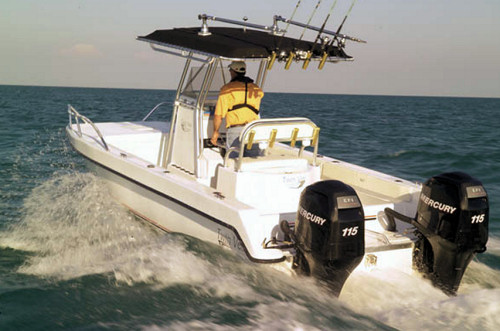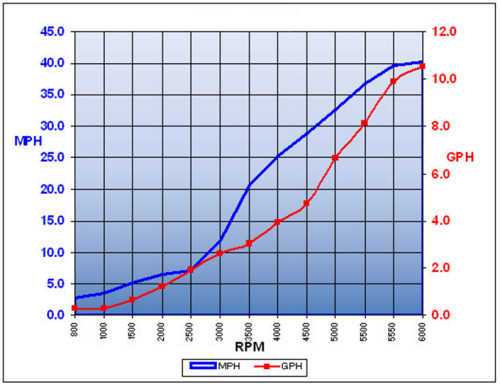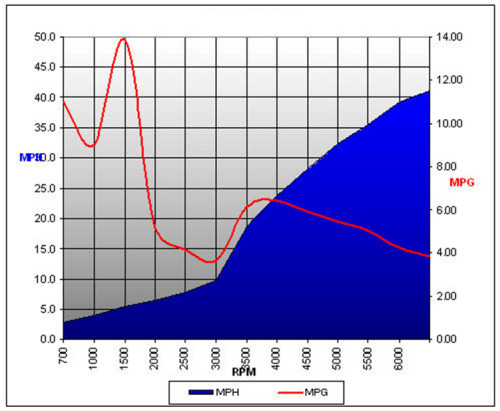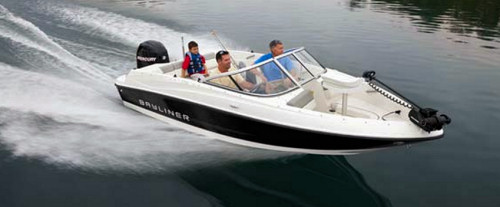Brief Summary
The Mercury 115 EFI four-stroke outboard is an in-line 4-cylinder that is made from the same 1.7 liter block and powerhead used in the 200-hp Verado. Many other components from its beefy big brother is used as well. The difference is that the 115 is not supercharged. But if it were, its block and head could handle the tremendous energy produced in those engines with almost twice as much power. We have all read enough engine-maker promos to know that they all say their engines are durable, but here is a case in point that is hard to deny. But that heavy-duty power head is only one of the things that the Mercury 115 has going for it.
Key Features
Specifications
| Type of Engine | 4-Stroke |
|---|---|
| Number of Cylinders | 4 |
| Horse Power | 115 |
| Configuration | In-line |
| Weight | 399.00lbs |
| Fuel Type | Gasoline |
| Fuel Delivery | Fuel Injected |
| Shaft Length Options | 20'' / 508 mm, 25'' / 635 mm |
| Shift Throttle Control | |
| Displacement | 105.70cu in |
| Steering Control | |
| Recommended Fuel | 87 octane |
| Alternator Output | 50 A |
| CARB Rating | 3-Star |
| Engine Monitoring System |
Captain's Report
The Mission of the Mercury 115
The 115 is designed to power a wide range of boats from 14' to 23' in a single-engine application and up to 28' in a twin installation. Her primary markets will be multi-specie aluminum boats, pontoon boats, bay boats, and utility boats of all sorts. Small, outboard-powered sportboats are also appropriate applications along with inflatable boats in both single and twin applications.
Distinguishing Features
- Robust Powerhead. Other four-stroke engines may have a similar displacement to the 115 Mercury, but none were designed to handle 200-hp supercharged output. In addition to the powerhead, other components are used from the Verado.
- Lightest Four-Stroke in Class. At 399 lbs. (181 kg.) the Mercury 115 is lighter than any other four-stroke and only 24 lbs. (10.9 kg) heavier than the lightest two-stroke outboard.
- Maintenance-Free Valve Train. The 115-hp Mercury has the same shim-free valve architecture as the Verados, which means no valve maintenance for life.
- World-Class Saltwater Corrosion Protection. Only Mercury offers a limited 3-year corrosion-failure warranty. The reason it can offer this warranty is because of the metal alloys employed, Mercury's special hard-anodizing coating system and painting process, and the number of 300 Series stainless steel parts used.
- Low Gear Ratio. The Mercury 115 has a gear ratio of 2.33:1 which provides low-end torque throughout the entire rpm range.
- 50 AMP Alternator. The Mercury 115 produces twice the AMPs as its prime four-stroke competitor.
- SmartCraft Diagnostics. This system provides real-time information from fuel management to boat speed to alerting the operator to potential problems from several causes.
- Troll Feature. This SmartCraft feature allows the operator to set a trolling speed down to as low as 650 rpms, in increments of 10 RPM.
- Optional "Big Tiller" Steering. An optional center-mounted tiller is available in a manual or power steering version, on both new boats and repower applications. It has smooth shifting, troll control, a handy power trim toggle, throttle friction for fine-tuning, and locks in two positions for trailering and operating.
Mercury has designed its 115-hp engine to be easy to maintain. Oil changes are particularly easy because of the handy locations of the components.
Major Features
- DOHC. (Double Over Head Cams), four valves per cylinder.
- Performance Trim Range. Negative 4-degree for strong holeshots and positive 16-degree for excellent top speed.
- EFI. Electric Fuel Injection means that the exact amount of fuel and air needed is electronically controlled for max efficiency, instant power response, and reliable starting every time.
- Low Maintenance. The Mercury 115 has been designed for low maintenance and easy maintenance. See below.
- Engine Guardian System. When overheating, low oil PSI, over-revving, or low battery voltage occurs, an audible alarm or visual alert will be sent. In some cases, the system will automatically reduce the engine's revs to protect the engine from catastrophic damage from low oil pressure or overheating.
- Positive Lubrication. The internal engine components are bathed in oil to reduce wear for longer life.
Performance
We have tested a dozen boats with the Mercury 115 EFI four-stroke outboard but Mercury Marine has tested many more. In looking over all of the data from both sources, here was what we discovered:
Sportboat Application
More and more small sportboats are being offered in outboard configurations, and although we have only conducted a few tests in this type, we see some consistency of some data points. These boats tend to be from 16' to 20' (4.87 m to 6.09 m), made of fiberglass, and weigh from 1,500 lbs. to 2,100 lbs. (681.8 kgs. to 954.5 kgs.) The beam of 16' boats is around 7' going up to about 8' for 20-footers. We saw deadrise angles at the transom ranging from 15-degrees to 19-degrees.
The boats we looked at both were 3-blade and 4-blade aluminum props with different geometry. 19" pitch seemed to give the best top speed results with good planing times.
WOT & Best Cruise. The top speed of both the lightest and the heaviest boats studied was over 40 mph, even though there was a 300 lbs. difference in the dry weights. Most economical cruise speeds seemed to be from 20 to 23 mph where the boats got from 4.9 to 7.4 mpg (for the lightest boat). Bottom shape also seemed to be an important factor as the fastest boats had a deadrise of 15-degrees and the slowest at 19-degrees.
Hole Shots. The best time-to-plane we recorded was 2.9 seconds, which is very quick, indeed. Most boats were in the three to four-second range.
Multi-Species Boats
Typically these boats are aluminum, but there were a few fiberglass boats tested as well. The boats we studied ranged from 17' to 20' and from 1,300 lbs. to 1,800 lbs. The beams were all about the same, around 7'10". Here we saw some definite trends and all three make sense:
- Greater pitch seems to result in higher WOT speeds, and
- Deeper deadrise at the transom appears to slow the boat down.
- Lighter boats go faster.
Nothing is earth-shaking about these observations, they are just important to keep in mind when judging boat performance.
WOT & Best Cruise. WOT speeds ranged from 37 mph (14" pitch prop) to the low 40s (19" prop and 14-degree deadrise). The most efficient cruising speeds generally clustered from 18 to 28 mph. Here we saw miles per gallon numbers, ranging from 5.4 gph (the heaviest boat) to 7.5 gph (the lightest boat).
Time-to-Plane. Time-to-plane was in the high four-second range, depending on deadrise (deeper is slower), weight and prop geometry. 4-blade props are generally faster out of the hole.
Pontoon Boats
The tests we observed ranged from 21' to 26'. The larger boats all had weighed around 2,500 lbs. and the boats performed about the same no matter which company built them.
WOT & Best Cruise. All of the boats we studied powered by the Mercury 115 had WOT speeds of 24 mph, except for the smallest and lightest boat which went one mph faster. Most efficient cruising speeds were in the mid teens and all of the boats got from 4.5 to 4.9 mpg at these speeds.
Time-to-Plane. This measurement is exceedingly difficult to get on pontoon boats, but generally, we would say that they averaged 2 to 3 seconds slower than on other types of boats.
Center Console Boats
Here we could find only a few boats that had been tested. They ranged from 17' to 19' and from 1,650 lbs. to 2,800 lbs. dry, and all were fiberglass. All three were designed for different types of work, so we did not find comparisons instructive.
WOT & Best Cruise. Top speed of these boats was 41 mph and the slowest was 33 mph. Best cruise speeds all came in the low 20s and fuel economy ranged from 5.5 mpg to 6.4 mpg.
Summary
Verado Powerhead. Our big takeaway from our study of the Mercury 115-hp four-stroke is the bulletproof nature of its powerhead. Clearly, this is an engine that should go on ticking for a long, long time due to the fact that it is overbuilt for both its horsepower and applications. It also used numerous components from the Verado series.
Maintenance-Free Valve Train. Virtually all four-stroke engines need their valve lash adjusted after so many hours of operation. This is a costly service call that is mandatory and it is eliminated on the Mercury 115.
Saltwater Corrosion Warranty. Mercury Marine as a matter of company policy is dedicated to providing the best outboard engines on the planet for use in saltwater. To that end, it is doing everything it possibly can to make Mercury a name that saltwater boaters can trust. It feels so strongly about the new anti-corrosion measures taken by the company, it will bet a 3-year anti-corrosion warranty on it.



